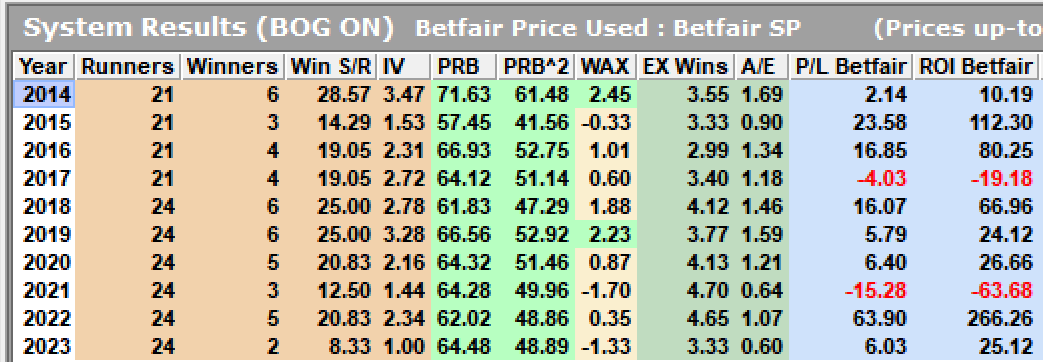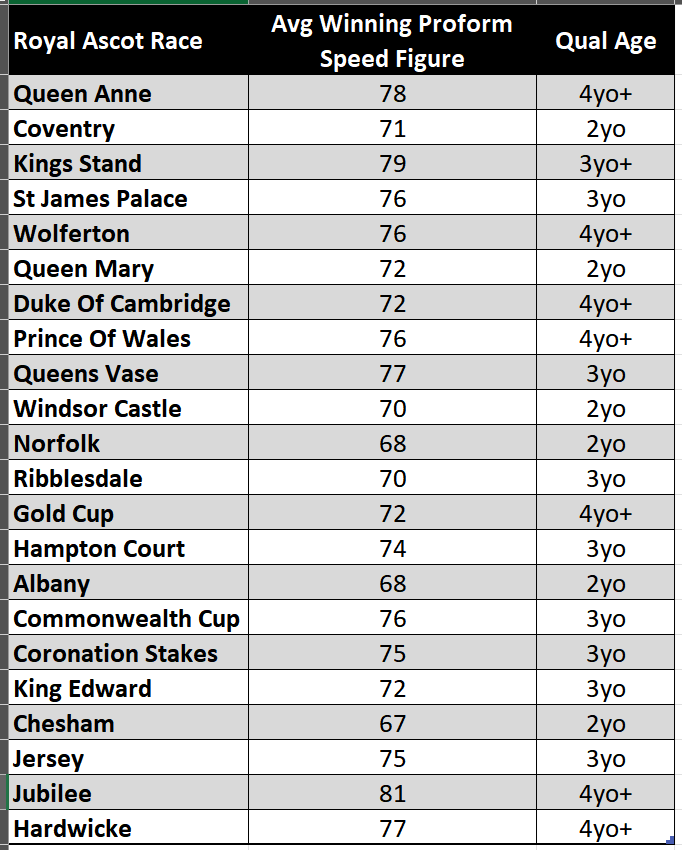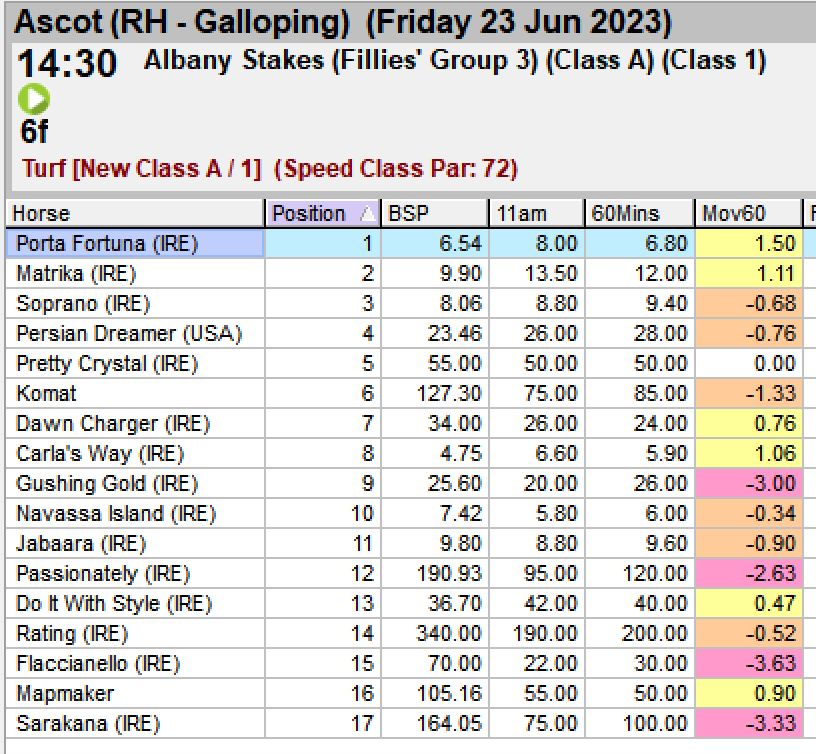Building a Rating Set for Royal Ascot + Speed Pars for every Pattern Race + Market Movement Analysis
June 13th, 2024By Paul Fitzgerald
NOTE: You can click on any image to view in a new window, and you can download a PDF copy of this article on this link
With Royal Ascot less than a week away now, it’s time to get into research mode and prepare for the feast of top-quality racing that shortly awaits us. I’ve always found the myriad of analytical tools contained within the Proform software to be a huge help in this regard.
As with the Cheltenham Festival, what I find most enjoyable in terms of research for Royal Ascot is looking for angles in the long-established Class 1 non handicap races. These races attract a similar calibre of horse each year, raw equine ability matters, and reliable benchmarks for the level of ability required to achieve victory can be established from the many previous running’s of each individual contest.
Royal Ascot features 22 long established Group and Listed races over its five days. These are the races where the top and indeed elite racehorses compete against each other and are the races we will concentrate on for this article.
As anyone that has followed the sport for any length of time will know, in conservations of Royal Ascot it generally wont take too long before names such as Aidan O’Brien, Ryan Moore, Frankie Dettori, John Gosden, and phrases such as “Derby Winner”, “Ran well in the Guineas”, “Top Rated 2 year old”, “Ran a huge rating in…” etc., will be mentioned. Themes of top trainers, top jockeys and top racehorses regularly emerge.
So, to start I wanted to take a look at these themes and see if they are backed up by actual figures.
There were 215 Group and Listed races run at Royal Ascot over the last 10 editions of the meeting (2014-2023)
Using the Proform System Builder, I looked at the number of winners by Trainer, Jockey and Official rating rank (horse) for these races…
The figures returned in the tables below are quite revealing. In terms of Royal Ascot’s claim to be “reserved for the best” in terms of social occasion, a largely similar claim can be applied to its contestants, both human and equine when it comes to the actual racing action.
Jockey Group – Just 8 of the 194 jockeys that rode in these races won almost two thirds of them.
Trainer Group – Just 2.68% of the total trainer population in these races won almost 60% of them.
Official Rating Group (2yo races excluded) – Two thirds of all non 2yo races were won by the Top 3 Rated.
So how does this information help us to find winners and make a profit next week. And given that’s it based on the past what relevance will it have in the future anyway?
To address the latter point – Prestige, status, media exposure, relatively large prizemoney, breeding and bloodstock values, good old intra-millionaire equine warfare - to name but a few, are all wrapped up in five days racing next week. Annually that’s open-ended. Add in the rise of the “super-trainer”, wealthy owners with their “go-to” jockeys, and the seemingly ever-increasing trend of the best bloodstock ending up in fewer and fewer hands, it’s reasonable to assume that the concentration of power shown in the tables above will continue for a few years yet.
In terms of finding winners in the Group and Listed races next week, narrowing fields down to “Top Rated, trained by A P O’Brien, ridden by Ryan Moore” etc., will probably provide a few winners alright, but its market transparent stuff and over time is unlikely to achieve much in terms of betting profit.
So, the task was to consider the concentration of power as outlined above, whilst also producing something that may not be as readily identifiable to the market in terms of obtaining betting value.
Amongst the many rating sets to be found within the Proform Software, one that seems to go under the radar a bit are the PRC ratings. To the best of my knowledge, they are not used in the calculation of any of the Proform composite ratings or the signature Proform Power Rating. I don’t hear them mentioned much in the members group and they are not speed ratings. But they are calculated on a class weighting number, the finishing position last time out and the number of runners in the last race. There are four PRC ratings in the software, a PRC rating achieved for each of the last 3 runs, plus a rating that averages the ratings of those last 3 runs. Along with the horse ability component covered by the PRC ratings, I also wanted to factor in the Trainer, Jockey, and Trainer/Jockey factors and produce a rating that I hope would speak to the figures outlined in the tables above.
An illustration of what this looks like in the Proform software (Race Card) view can be seen in the picture below…
So, what I wanted to do was combine all 7 ratings into a composite rating lets call it FPR (Flat Pattern Rating) and then check how it performed at Royal Ascot between 2014 and 2023.
This next bit is boring spreadsheet work. I won’t go into too much detail here, but the spreadsheet will be available on the members group (Platinum membership required) by the weekend so the FPR rating can be easily calculated by any Proform member that wishes to do so.
The screen shot of the entire width of the spreadsheet isn’t legible, so it’s also divided into two parts to make it clearer.
Part 1…The WHITE and BLUE columns contain data imported directly from Proform. In the ORANGE columns all 7 ratings have been normalised to the same scale, namely 0 to 1. So, the top-rated value for each rating is awarded a 1, the bottom rated rating is awarded a 0 and all points in between. All ratings where no PRC values are awarded – common in 2yo races, less common in 3yo races but still enough of them, and foreign (non GB/IRE) runners with no previous runs in the database have been awarded an average PRC rating equivalent to their evening before price.
Part 2…The normalised ORANGE column values have then been weighted using my own machine learning process. To avoid the weighting process marking its own homework by using Royal Ascot data only, data from over 24000 UK Group and Listed races since 2013, excluding Royal Ascot was used to calculate the weightings.
It’s very simple – basically the normalised value in the ORANGE column is multiplied by its weighting for all 7 ratings in the GREEN column and those GREEN column values are then added together to produce a final rating in the PURPLE column.
For interest the weightings for the 7 rating sets returned as follows…
Of course, a race that worked out well is used as the example, but the first and second in the 2022 edition of Platinum Jubilee had solid UK and Ascot numbers from their previous form that is reflected well in their PRC Ratings, and connections numbers need no explanation at all. In any event we’ll do a full analysis of all results since 2013 in the next stage. This is easily achieved by importing our calculated ratings into one of the four User Rating columns available in the Proform software. They have been imported into User Rating 4 in this case, as shown below…
So now let’s do an analysis of how the FPR rating worked out over the last 10 years at Royal Ascot
Overall, the FPR rating for all races 2014-2023 returned as follows…
Top 3 Ranked combined…
Ranked 4 or more combined…
Top 3 Ranked combined by year…
Top 3 Ranked combined – Betfair place market
So overall FPR Top 3 Ranked performed quite well against the market when backed blind at BFSP (-2% commission) over the period. What’s interesting to me is that you now have a rating that is your own, is calculated using no market data, and where over the past ten years its basically evens that the race will be won by one of your Top 3 rated. Not a bad starting point for your analysis, particularly if you do some additional work on horses whose market rank is out of line with your own ranks.
Over the last 3 years alone FPR Top 3 Ranked has produced some nicely priced winners at Royal Ascot…
Of course, once imported into Proform you can analyse the ratings further using any of the literally dozens of filters and tools available in the System Builder.
I was interested to take a look at how the Top 3 Rated performed by Race Age Group.
At Royal Ascot the 22 Group and Listed races are divided into races for 2yo’s only, 3yo’s only and races for horses aged 3yo+/4yo+.
FPR Top 3 Ranked – 2yo Races Only
The A/E here is 0.95 – returns are below market expectation. Not too surprised by this. Many of the 2yo’s running at Royal Ascot will initially have had zeros across their PRC ratings as they simply haven’t run the requisite amount of times to generate “real” ratings. If you remember these zeros are replaced by pseudo ratings equivalent to the average PRC by evening before market price. In any event unexposed and relatively immature young horses can be open to large levels of improvement in relatively short periods of time that can be difficult to capture by numbers alone.
FPR Top 3 Ranked – 3yo Races Only
The A/E of 1.02 here is just about positive. But caveats similar to those for 2yo races should be applied.
FPR Top 3 ranked – 3yo+/4yo+ Races for Older Horses
FPR Top 3 ranked performed well when the ratings were applied to older horses, returning an A/E of 1.16 over the ten years. This age group are generally physically mature, and therefore not as open to sudden large improvements in form, and whose overall ability is easier to assess given most will have run multiple times in public by the time they have reached this age of their lives.
FPR Top 3 Ranked by Year – 3yo+/4yo+ Races for older horses
Winning Speed Rating Pars at Royal Ascot
Below is a table listing the average Proform Speed Rating achieved by the winners of all 22 Group and Listed races run at the meeting for the last 10 years (2014-2023)
To assist in narrowing down fields as part of the selection process, the tables below have divided into two cohorts the runners Highest Achieved Proform Speed Rating in the Last 1 Year, compared to the winning Speed Par by the qualifying age for each race.
So, for example looking at The Coventry Stakes (the second race on Day One), runners with a HA Speed Rating Last 1yr that is -4 or above of the average winning Proform Speed Rating for this race, as a group have performed much better than runners with a best last 1-year speed rating of -5 and below par. So, for The Coventry, runners with a HA Last 1 Year speed rating of 67 and above have vastly outperformed runners with a rating of 66 and below going into the race.
Market Movement at Royal Ascot
For some time now Proform has allowed the user to import market price data taken directly from the Betfair Exchange into its database through a simple import interface within the software. This literally takes seconds when updated on a daily basis. The market price data can then be analysed in the system builder. The data also contains market movement metrics that measure the magnitude of price change between different timestamps across the life of the pre-race market. All the information on this aspect of the Proform package is available online on this link
Basically, a positive number on the market movement metric indicates a shortening in price on the Betfair Exchange, and the opposite for a negative.
Here I’ve chosen to look at the Mov60 metric, which calculates the movement and magnitude between a runner’s price at 11am and 60 minutes before the race scheduled off time. Royal Ascot markets are strong, liquid, and will certainly be well formed by 11am on raceday. Using 60 minutes before off time gives at least a three-and-a-half-hour window for the market to further develop, and given the aforementioned general strength of these markets, often large volumes of money will be required to move prices. So, is that price movement significant?
Across our 22 Group and Listed Races (2014 to 2023)…
All runners with a positive Mov60 metric
All runners with a negative Mov60 metric
There will be a lot of attention on Aiden O’Brien and Ryan Moore next week.
Aiden O’Brien positive Mov60 metric
Aiden O’Brien negative Mov60 metric
Ryan Moore positive Mov60 metric
Ryan Moore negative Mov60 metric
The two-year-old races at Royal Ascot can be difficult for bettors to figure out. Two years olds can be relatively unexposed and open to large improvements in their form from one race to the next in the early stages of their careers. That improvement can be difficult to convert into numbers from a market point of view. Overall, the front two in the betting over the last 10 years in these races have underperformed against the market at BFSP.
So, have there been any clues from the earlier markets in these races over this period?
All runners in Royal Ascot 2yo Races – posative Mov60 metric
All runners in Royal Ascot 2yo Races – negative Mov60 metric
And finally, just a quick overview of how that looks in the software. Notice the Mov60 metric for those toward the head of the market and their actual finishing positions.
So, I’ll finish up with a word of caution. All of this data is really great for narrowing down fields, breaking down the complex into the manageable, providing horses to focus on, and when allied to your own analysis of trip/going requirements, pace/position setup etc, etc, etc, can be a very powerful weapon against the market. But there is literally no point in applying any of this analysis for example to a horse that won’t stay beyond a mile if you’re looking at a ten-furlong race. Do your own work too. Fit the horse to the angle not the other way around.
Best of luck and enjoy what will hopefully be five great days of racing.
By Paul Fitzgerald
Age 53. Live in County Clare, Ireland.
Followed racing most of my life since watching Red Rum win the 1977 Grand National.
Prefer flat racing.
Been with Proform for more years than I care to remember at this stage, so pretty familiar with the software and its functionality.
Mainly data-based approach to racing. Build my own models, which I combine to calculate a base probability. Adjust that base probability with my own subjective opinion to form a final price, which I then take to the market.
Use Betfair only.
*Proform Telegram Members Group
Proform Subscribers can join the Telegram group chat for which can be used for support, systems
ideas, sharing selections and much more.
If you would like to join, then send me a message on Telegram with your name and your
Proform login email address and we will add you to the group chat.
My telegram username is @proformracing
You can download Telegram on your mobile from here https://telegram.org/
and there is also a desktop version you can install on your computer.
NOTE:
You need to open Telegram on your mobile.
Click on the 3 lines in the top left corner of the screen.
Click on Contacts.
Enter Simon Walton or my telegram name which is @proformracing into the name’s fields and my mobile number 07984 648774.
You should then be able to contact me and give me your full name so we can see that you are a
subscriber and then we can add you to the group



































